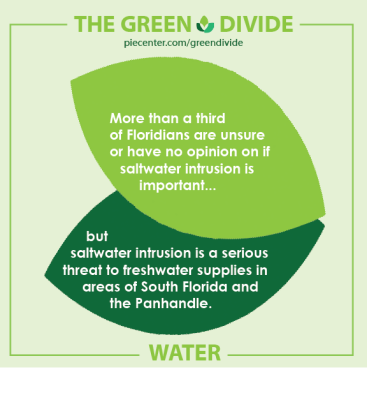 Underground aquifers supply 90 percent of the state’s drinking water, more than 8 billion gallons of water each day. Florida’s geography as a peninsula surrounded by water puts coastal communities at a unique risk for saltwater intrusion into these aquifers that contain the state’s freshwater supplies. There are several factors that can contribute to saltwater intrusion but drought and increased water withdrawals are leading causes. A changing climate and rising sea levels are expected to exacerbate saltwater intrusion. Saltwater intrusion can lead to a higher concentration of minerals or salts in the water, degrading the quality, and resulting in water that does not meet drinking-water standards. The line of saltwater spreading inland comes close to or reaches cities from Jupiter to Florida City including West Palm Beach, Delray Beach, Boca Raton, Fort Lauderdale, Hollywood, and Miami. Saltwater intrusion also threatens the aquifer that supplies freshwater to coastal and inland areas of Escambia, Santa Rosa, Okaloosa, Walton and Bay counties. As a result, economically and environmentally favorable alternative water supply options have been adopted or are being explored to sustain water resources and associated natural system as well as keep the freshwater flowing for public consumption, and meet future water demands.
Underground aquifers supply 90 percent of the state’s drinking water, more than 8 billion gallons of water each day. Florida’s geography as a peninsula surrounded by water puts coastal communities at a unique risk for saltwater intrusion into these aquifers that contain the state’s freshwater supplies. There are several factors that can contribute to saltwater intrusion but drought and increased water withdrawals are leading causes. A changing climate and rising sea levels are expected to exacerbate saltwater intrusion. Saltwater intrusion can lead to a higher concentration of minerals or salts in the water, degrading the quality, and resulting in water that does not meet drinking-water standards. The line of saltwater spreading inland comes close to or reaches cities from Jupiter to Florida City including West Palm Beach, Delray Beach, Boca Raton, Fort Lauderdale, Hollywood, and Miami. Saltwater intrusion also threatens the aquifer that supplies freshwater to coastal and inland areas of Escambia, Santa Rosa, Okaloosa, Walton and Bay counties. As a result, economically and environmentally favorable alternative water supply options have been adopted or are being explored to sustain water resources and associated natural system as well as keep the freshwater flowing for public consumption, and meet future water demands.
For more information on Florida’s aquifers and saltwater intrusion:
- Florida’s water resources
- Florida’s aquifers- What is an aquifer?
- The Floridan Aquifer System
- West-Central Florida’s Aquifers
- Ground Water in Freshwater-Saltwater Environments
- The Northwest Florida Water Management District’s Regional Water Supply Plan for Santa Rosa, Okaloosa, and Walton Counties

















